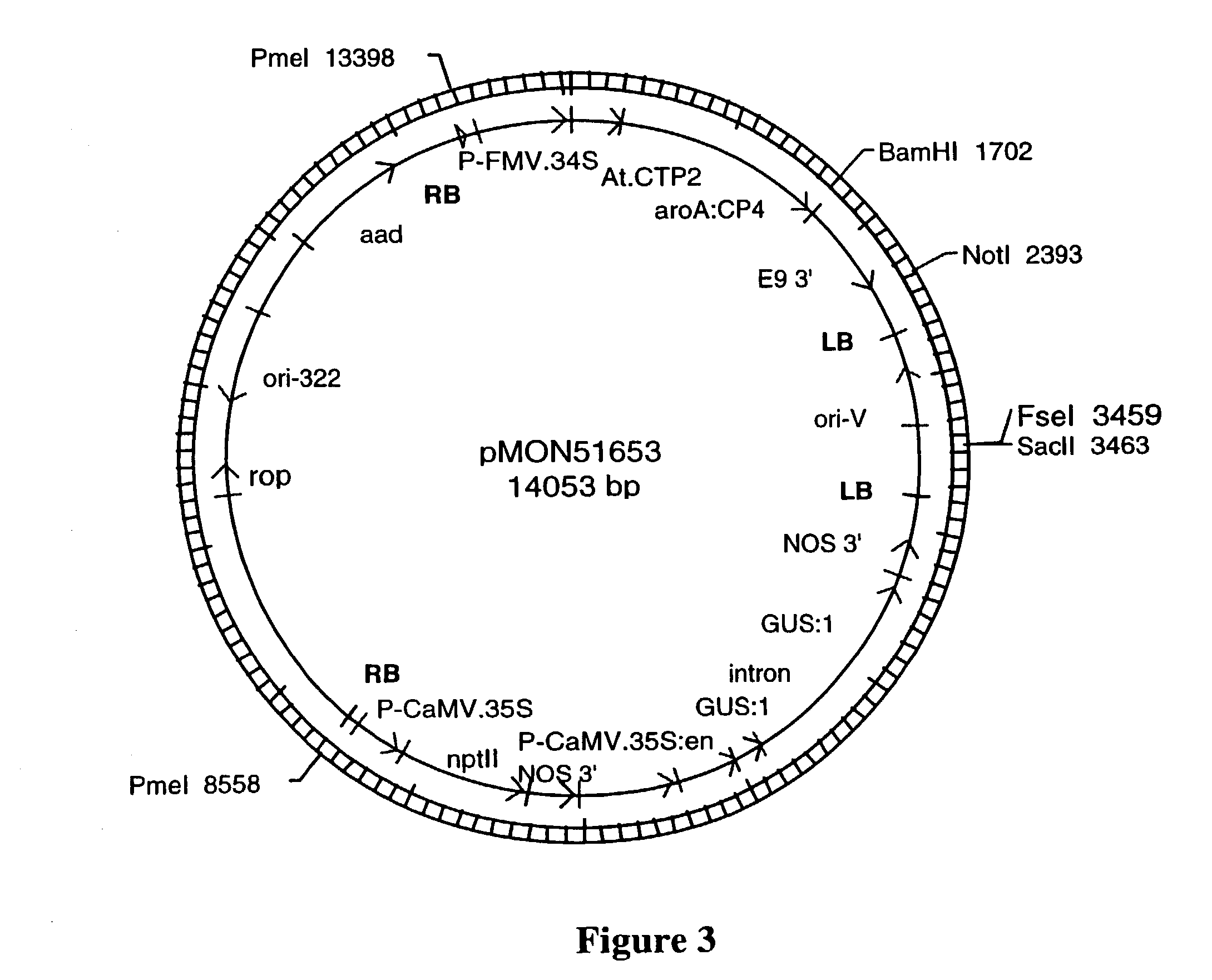Methods for enhancing segregation of transgenes in plants and compositions thereof
a technology of transgene segregation and plant, applied in the field of plant genetic engineering, can solve the problems of reducing efficiency and adding to the cost of production events, and achieve the effect of enhancing yield and enhancing nutrition
- Summary
- Abstract
- Description
- Claims
- Application Information
AI Technical Summary
Benefits of technology
Problems solved by technology
Method used
Image
Examples
example 1
[0183]The use of conditional lethal transgenes in two T-DNA constructs involves the construction of plant transformation vectors that include the appropriate combination of genetic elements necessary to direct adequate expression levels in target tissues. For monocotyledonous crop plants, a monocot vector that utilizes a plant expression cassette that contains a promoter (P) and first intron (I) for example, from the rice (Os) actin gene (P-Os.Act1 / I-Os.Act1 (U.S. Pat. No. 5,641,876, herein incorporated by reference in its entirety). DNA molecules that encode targeting sequences may be used when determined by those skilled in the art that it would contribute to the desired phenotype, for example the plastid transit peptide sequence from the Arabidopsis thaliana (At) EPSP synthase gene (At.CTP2) (Klee et al. Mol. Gen. Genet. 210:437-442, the entirety of which is herein incorporated by reference) would be an appropriate choice. The choice of the conditional lethal transgene coding seq...
example 2
[0185]Transgenic corn plants can be produced by an Agrobacterium mediated transformation method. The constructs, pMON42070 (FIG. 9), pMON42071 (FIG. 10), pMON42072 (FIG. 11), a 1 T-DNA construct pMON42073 (FIG. 8) as a control construct, and constructs derived from these containing a conditional lethal gene inserted into the DNA segment located between the two T-DNAs are used to transform corn cells. For example, pMON73105 (FIG. 15, [RB]P-CaMV.35S / nptII / nos3′[LB]; [RB]P-Os.Act1 / GUS:l / T-Ta.Hsp17[LB]; P-FMV / I-Os.RbcS / pehA2 / nos3′; and pMON73107 (FIG. 16, [RB]P-CaMV.35S / nptII / nos 3′[LB]; P-FMV / pehA2 / nos 3′; [RB] P-Os.Act1 / GUS:1 / E9 3′[LB]) construct of the present invention has an expression cassette for pehA2 inserted in one of the DNA segments of the construct. DNA constructs of the present invention have a conditional lethal gene inserted into both DNA segments, for example, pMON73106 (FIG. 17, [RB]P-CaMV.35S / nptII / nos3′[LB]; P-ScBV / I-Os.Act1 / pehA2 / nos3′; [RB] P-Os.Act1 / GUS;1 / T-Ta.Hs...
example 3
[0203]Strong constitutive promoters may influence the expression of linked transgenes that contain tissue or organ specific promoters, this results in an aberrant expression pattern from the tissue or organ specific promoters referred to as leaky expression. The leaky expression of a transgene product in non-targeted tissues is an important issue for transgenic plants, especially if the expression in the non-target tissues causes undesirable phenotypes. Additionally, often the true expression pattern and promoter strength of a tissue specific promoter cannot be precisely determined because of the influence of a linked expression cassette containing a constitutive promoter. The present invention provides a method where DNA constructs that allow for the separate integration of T-DNAs are used to reveal the true expression pattern of tissue specific promoters. The method provides plants with tissue specific expression cassettes free from an expression cassette containing a selectable m...
PUM
| Property | Measurement | Unit |
|---|---|---|
| pH | aaaaa | aaaaa |
| size | aaaaa | aaaaa |
| size | aaaaa | aaaaa |
Abstract
Description
Claims
Application Information
 Login to View More
Login to View More - R&D
- Intellectual Property
- Life Sciences
- Materials
- Tech Scout
- Unparalleled Data Quality
- Higher Quality Content
- 60% Fewer Hallucinations
Browse by: Latest US Patents, China's latest patents, Technical Efficacy Thesaurus, Application Domain, Technology Topic, Popular Technical Reports.
© 2025 PatSnap. All rights reserved.Legal|Privacy policy|Modern Slavery Act Transparency Statement|Sitemap|About US| Contact US: help@patsnap.com



